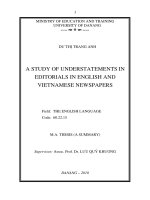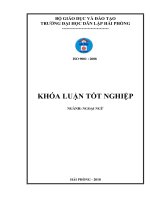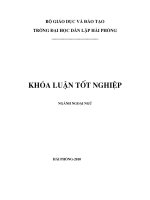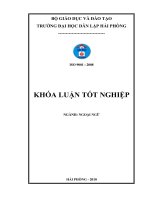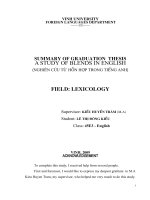Limited distribution channel a study from ladofoods in the southern region
Bạn đang xem bản rút gọn của tài liệu. Xem và tải ngay bản đầy đủ của tài liệu tại đây (1.14 MB, 69 trang )
UNIVERSITY OF ECONOMICS HO CHI MINH CITY
International School of Business
------------------------------
PHAN THI MINH NGOC
Limited distribution channel: A study
from Ladofoods in the Southern region
MASTER OF BUSINESS ADMINISTRATION
Ho Chi Minh City – Year 2021
UNIVERSITY OF ECONOMICS HO CHI MINH CITY
International School of Business
------------------------------
PHAN THI MINH NGOC
Limited distribution channel: A study
from Ladofoods in the Southern region
MASTER OF BUSINESS ADMINISTRATION
SUPERVISOR: Assoc. Prof. Dr. NGUYEN THI MAI TRANG
Ho Chi Minh City – Year 2021
CONTENTS
LIST OF TABLES ............................................................................................................. v
LIST OF FIGURES ........................................................................................................... v
1
2
COMPANY OVERVIEW .......................................................................................... 1
1.1
History ................................................................................................................... 1
1.2
Strategic vision ..................................................................................................... 3
1.3
Organizational chart ............................................................................................ 4
PROBLEM IDENTIFICATION ............................................................................... 6
2.1
Problem context.................................................................................................... 6
2.1.1
Economic factors affecting the wine industry ............................................ 6
2.1.2
Social factors influencing the wine industry ............................................... 7
2.1.3
Customers’ analysis ...................................................................................... 8
2.1.4
E-commerce channel supporting the wine industry .................................. 9
2.2
Symptom ............................................................................................................. 11
2.3
Potential problems ............................................................................................. 12
2.3.1
The first potential problem: Wine frauds ................................................. 13
2.3.2
The second potential problem: Limited distribution channel ................ 15
2.3.3
The third potential problem: Low brand value ....................................... 17
2.4
Main problem validation ................................................................................... 21
2.4.1
Eliminating pressure in wine frauds and low brand value ..................... 21
2.4.2
Illuminating limited distribution channel as the main problem ............. 22
2.5
Potential causes .................................................................................................. 25
2.5.1
Traditional channel ..................................................................................... 26
2.5.2
Conflict within the channel ........................................................................ 29
2.6
3
Cause Validation ................................................................................................ 30
ALTERNATIVE SOLUTION ................................................................................. 33
3.1
Alternative solution 1: recruiting human resources to develop other sales
channels. ........................................................................................................................ 33
3.2
Alternative solution 2: Built an e-commerce channel..................................... 35
3.3
Solution justification .......................................................................................... 37
3.4
Action plan .......................................................................................................... 38
4
EXECUTIVE SUMMARY ...................................................................................... 41
5
SUPPORTING INFORMATION ........................................................................... 42
5.1
Secondary data ................................................................................................... 42
5.2
Primary data ....................................................................................................... 42
APPENDIX 1: QUALITATIVE RESEARCH .......................................................... 46
APPENDIX 2: QUANTITATIVE RESEARCH ....................................................... 54
REFERENCES ................................................................................................................ 61
LIST OF TABLES
Table 1: Average population by residence in Ho Chi Minh city....................................... 23
Table 2: Estimated cost of recruiting human resources .................................................... 34
Table 3: Estimated cost of creative an e-commerce channel ............................................ 36
Table 4: Action plan .......................................................................................................... 39
Table 5: Qualitative: Initial Understanding ....................................................................... 43
Table 6: Qualitative: Problems .......................................................................................... 43
Table 7: Quantitative: Problems ........................................................................................ 44
Table 8: Qualitative: Causes ............................................................................................. 44
Table 9: Qualitative: Solution ........................................................................................... 44
LIST OF FIGURES
Figure 1: Chateau Dalat ....................................................................................................... 2
Figure 2: Organization chart of Ladofoods ......................................................................... 5
Figure 3: Annual International Wine Imports in Vietnam (4)............................................. 7
Figure 4: Percentage contribution to revenue by customer type between 2017 – 2019...... 9
Figure 5: The market share of online B2C segment in Vietnam is growing in the period
2014-2020 .......................................................................................................................... 10
Figure 6: Sales revenue of Ladofoods ............................................................................... 11
Figure 7: Vietnamese imports of wine by country ............................................................ 12
Figure 8: Recognized the right brand of Chateau Dalat .................................................... 14
Figure 9: Where customers by Chateau Dalat ................................................................... 16
Figure 10: Gender of respondents ..................................................................................... 18
Figure 11: Age of respondents .......................................................................................... 18
Figure 12: Occupations ...................................................................................................... 19
Figure 13: Cause-and-Effect map ...................................................................................... 21
Figure 14: Chinese distribution channel system ................................................................ 24
Figure 15: Fish bone diagram of main problem and potential causes ............................... 26
Figure 16: Ladofoods product portfolio does not support e-commerce purchases ........... 27
Figure 17: Product flow diagram of Ladofoods distribution channel ............................... 29
Figure 18: cause-and-effect map ...................................................................................... 32
1 COMPANY OVERVIEW
1.1 History
Lam Dong Joint Stock Company inherits the know-how and experience in making wineries
on the basis of the French Lafaro winery built in 1933 which has developed continuously.
(1)
In 1999, Vang Dalat, the first official wine product of Vietnam, was launched. Since then,
the brand name Vang Dalat has been popular with wine lovers.
Ladofoods has officially established LADORA WINERY – Vietnam’s first professional
winery in early 2015. (1) At the same time, Ladofoods Trading Service One Member Co.,
Ltd. was headquartered at 8th floor, KICOTRANS building - 46 Bach Dang, Ward 2, Tan
Binh District, Ho Chi Minh City and Representative Office in Hanoi. Especially, Ladora
Farm Ninh Thuan Company (Ladora Winery vineyard) was located at Phu Thuan village My Son - Ninh Son - Ninh Thuan.
Ladofoods has made efforts to research and bring back to Vietnam the varieties most
suitable to the soil characteristics of Vietnam were found in cooperation with European
experts in 2008.
The Ladofoods wines are perfectly combined by grape growing techniques, wine
fermentation process, among other advanced technologies transferred from leading
companies and experts from the cradles of wine in Europe. The goods are also inspired by
the love for wine and the desire to mark Vietnam as a wine destination on the global map.
(1)
Nowadays, millions of bottles of Ladofoods wines are consumed yearly in Vietnam and
exported to foreign markets. In which, Vang Dalat and Chateau Dalat have consolidated
the position of an internationally standard brand that is widely preferred by both domestic
and international wine lovers. In more detail, Vang Dalat is the first wine brand in Vietnam
whereas Chateau Dalat is a fine wine brand with a class that can rival international wines.
1
Figure 1: Chateau Dalat.
(Source: image of Chateau Dalat)
Milestones:
1999: Vang Dalat was the first official wine product of Vietnam.
2006: Vang Dalat was chosen by the Government to serve at APEC 2006.
2016: Chateau Dalat Signature Shiraz, which is a product of Ladofoods, won the Cathay
Pacific International Wine & Spirit Competition 2016. There was the first time that
Vietnamese wine had been listed on the wine world map.
2017: Chateau Dalat was elected by the Government to serve Heads of States at APEC
2017.
2018: Chateau Dalat and Vang Dalat were accepted as National Brands 2018.
2019: Dalat Wine Cellar which was the largest underground wine cellar and the first
European-standardized wine cellar in Vietnam was inaugurated. The property represented
continuous efforts of Ladofoods to affirm its position as Vietnam’s No. 1 Winemaker.
2
1.2 Strategic vision
Vision
“To build, develop and remain the position of Ladofoods as the No. 1 brand in domestic
wines and products made from vines in Vietnam, expanding to regional as well as global
markets”. (2)
Core values
Quality:
Ladofoods has always put the top priority on "Wine meeting international standards".
The wine of Ladofoods is beautiful blend fermented by the souls and skillful hands of
Vietnamese people. With the definite passion for wine, Ladofoods is committed to provide
customers with wines and related products that meet international standards and are safe
for health. At the same time, Ladofoods is gradually building up the winery culture in the
community, contributing to the enrichment of Vietnamese culinary culture.
Innovation and creativity:
Ladofoods considers innovation and creativity as the foundation for sustainable
development, the leverage of innovation, and the distinction that creates the pioneering
strength of the company.
To keep pace with market growth, Ladofoods encourages the spirit of continuous
innovation and creativity, advanced application in science and engineering, and technology
of production and management in order to improve quality of products and services.
Human Resource:
Defining people as the foundation of the company's success, Ladofoods always strives to
build a professional and dynamic working environment. Moreover, we appreciate the
cohesion so that employers always try their best and achieve their goals.
3
Strategic orientation
To develop and maintain the pioneering and leading position of Vietnamese wine brands.
To constantly innovate, revolute, practice, and create values to deserve the position as the
first official and leading Vietnamese wine brand.
To protect and develop brand reputation; build and continuously enhance the cultural
identity of the company as well as the wine brand; encourage creativity to maintain
diversity; ensure high competitiveness; and always adapt to business environment and
sustainable development.
To always focus on customers’ satisfaction; cooperate closely with partners in the sense of
trust, respect, and equality for common success.
To actively contribute to the overall development of society to build a good and civilized
community, thereby promoting local and national socio-economic development.
1.3 Organizational chart
The Board of Directors consists of 09 members, the Supervisory Board includes 05
members, the Directors 03 people, the Chairman and Board members mostly hold key
positions in the company, from the Head of Operations Department and equivalent above.
The company has 5 professional offices, 2 representative offices in Ho Chi Minh City and
Hanoi. The company's organizational apparatus operates on a functional organizational
structure. Average number of employees in 2019 was around 3.962 people, of which
women accounted for nearly 80%, college-secondary level and technical workers
accounted for 12%, the rest 88% of workers with low education, of which 42% workers
with skilled workers level 2 or higher. Average income of employees increased from 10%
to 20% per year.
4
Note:
direct relationship
interactive relationship
Figure 2: Organization chart of Ladofoods
(Source: Ladofoods internal information)
5
2 PROBLEM IDENTIFICATION
2.1 Problem context
2.1.1 Economic factors affecting the wine industry
Vietnamese wine companies are facing the risk of fiercer competition due to the free trade
market for many products. Many foreign companies are importing wine into Vietnam
leading to consumers have more choices at lower prices which create a fiercely competitive
market for domestic businesses.
According to the General Statistics Office (GSO), Vietnam's gross domestic product (GDP)
increased 7.02 percent in 2019. Especially, in 2019, total export and import revenue of
goods and services is equivalent to 210.4 percent of the GDP, indicating that Vietnam has
managed to capitalize on the domestic economy's advantages and make use of global
markets, the official said. (3)
The alcohol export sector also increased by 10.7% compared to 2016 and it is forecasted
to continue to increase. (4) Moreover, residents' consumption also continued to increase by
nearly 11.9%. (3)
According to Duc, the import tax on wine in Vietnam is quite high at 90% including import
tax 50%, special consumption tax 30% and value added tax 10%. (5) Although the import
tax on wine in recent years is still maintained at such a high level, the amount of wine
imported into Vietnam has increased rapidly. In more detail, the wine imports to Vietnam
were 155,793,110 USD in 2016 after that there was slightly increase to 189,717,902 USD
by 21.8% in 2017. It is noticeable that the figure for the year 2018 dominated that of 2019
($292,172,544 and $312,360,717, respectively). (4) Meanwhile, the ability to export
Vietnamese wines is still limited.
6
350,000,000.00
300,000,000.00
250,000,000.00
200,000,000.00
150,000,000.00
100,000,000.00
50,000,000.00
0.00
2016
2017
2018
2019
World
Figure 3: Annual International Wine Imports in Vietnam (4)
2.1.2 Social factors influencing the wine industry
The Vietnamese people's civil rule education has improved a step significantly. The socioeconomic conditions of the people have been improved, leading to increased demand and
consumption. The tastes of customers have also changed towards a higher desire, requiring
better and more diverse products. The changing cultural life helps many people to have
new habits following the trend of internationalization, and use wine instead of other
traditional beer and wine, this is an advantage for increasing consumption of Ladofoods.
The urban population with high purchasing power is increasing with the speed of
urbanization. As part of this development, it has undergone considerable urbanization, as
the proportion of the population living in urban areas increased by 50% between 2000 and
2018. (6) Compared to 2009, there were 6.7 million migrants, accounting for 8.5% of the
Vietnamese population. The per capita target in urban areas is also 2.5 times higher than
that in rural areas. Furthermore, the urban population is projected to increase by about 50%
by 2069. (3)
7
The tourism industry in 2019 increased by 16.2% compared to 2018 in international
arrivals and 85 million domestic tourists. (7) In addition, the number of days of stay of
guests will also be longer due to the strong investment in tourist attractions across the
country. In recent years, many foreigners come to Vietnam to travel and do business, this
is the main target for wine consumption.
Nevertheless, most of the rural population has a habit of using rice alcohol, due to low
income and less influence by Western culture. A small part of the urban population tends
to use wine, but the knowledge of wine consumption is limited. This is because consumers
choose products based on price and place of manufacture. There is a few with high income
and knowledgeable levels about wine is very strict in choosing products and often tend to
choose imported wines.
Moreover, counterfeiting is still popular in the Vietnamese market. The law on that issue
is lax and the penalty level is quite weak. The infringement of industrial property rights on
trademarks is still common, affecting the efficiency of production, infringed businesses
and legitimate interests of consumers.
In conclusion, social and economic factors are both threats and opportunities for
Ladofoods.
2.1.3 Customers’ analysis
Ladofoods is operating in both business-to-business (B2B) and business-to-customer
(B2C) sectors. However, the company is still working towards the development of the first
group of customers because of the second group of customers there is only one showroom
on Dien Bien Phu street.
Looking to the figure 4 in more detail, we can see that contribution to total revenue of
Ladofoods by B2B accounted a dominant position. In the year 2017, the percentage of
contribution to revenue B2B made up 73% contribution to revenue whereas that of B2C
constituted 27%. This trend had a slight change in two years from 2017 to 2019. Even
8
though the proportion of contribution to revenue B2B decreased to 70%, that of customers
still higher than B2C rate.
100%
90%
80%
70%
60%
50%
40%
30%
20%
10%
0%
2017
2018
B2B
2019
B2C
Figure 4: Percentage contribution to revenue by customer type between 2017 – 2019
(Source: Internal Data)
Although B2B customers are more than B2C customers, we can see that this B2C audience
is on an upward trend. Hence, this thesis will focus on the B2C target group.
2.1.4 E-commerce channel supporting the wine industry
There is a broad range of Internet-based Electronic Commerce (e-commerce) applications
that firms may utilize to develop business strategies in the digital age. Such initiatives can
bring about significant changes of business processes or even industry structures, as early
examples have demonstrated.
This is essential to link the business model to a marketing model – the nature of the
competitive advantage, the positioning of this advantage, the marketing mix and the
product–market strategy. One area that has received attention from the beginning of the
commercial use of the Internet was the online retailing of wine. Together with website and
9
online retailers such as Winecellar, TMwine and other e-flatforms emerged early on as an
example of innovative.
Moreover, e-commerce channels are also a lifeline for wine producers during the Covid19 epidemic situation, not only other products but also wine products. If companies do not
grasp the market and change, it will be difficult for businesses to overcome this external
Billion USD
factor.
B2C group revenue (left)
% Retail sales (right)
Figure 5: The market share of online B2C segment in Vietnam is growing in the period
2014-2020
(Source: VND RESEARCH, DELOITTE 2019)
Even though, retailers are struggling to survive in the short term, the crisis also presents
opportunities; retailers who invest heavily and promptly in their online business are likely
to become market leaders.
10
2.2 Symptom
In order to clarify more about Ladofoods' abilities, I conducted an exploration of the
internal and external possibilities. According to Ladofoods’ annual report, the line chart
illustrates the figure for sales revenue of Ladora Winery between 2017 and 2019. It can be
seen that there was a downward trend in a number of sales revenues of Chateau Dalat
during the period of 3 years. Looking the information in more detail, we can see that it is
noticeable that the figure for sales revenue in 2017 reached the highest point which
exceeded that of 2018 (586,780 million VND, 549,215 million Vietnam dongs,
respectively). After that, this trend continues decline to 306,729 million VND in 2019.
Overall, Ladofoods dropped 47.7% in sales revenue from 2017 to 2019.
700,000
600,000
586,780
500,000
459,215
400,000
306,729
300,000
200,000
100,000
0
2017
2018
2019
Net revenue
Figure 6: Sales revenue of Ladofoods
(Source: Ladofoods’ annual report)
Nevertheless, the imported wine market has never felt down. In the past few decades, the
volume of wine imported into the Vietnamese market has been constantly increasing.
Despite years of difficult economic conditions, the output of foreign wine has steadily
11
grown up. This shows the importance and the influence of wine on Vietnamese life and
culture. Imported wine market in Vietnam is currently popular with wines from Chile,
France and Italy, in addition to other countries. In general, the wine market has a diversity
of types and price so users can easily choose the type of wine that suits the needs and
purposes.
Figure 7: Vietnamese imports of wine by country
(Source: Trade map)
To sum up, the fact that Ladora Winery cannot be successful in its sales revenue even
though the foreign wine consumption is increasing in Vietnam. As a result, this symptom
is the starting point for deeper analysis of the current problem of Ladofoods.
2.3 Potential problems
In order to find out the causes that lead to the symptom of Ladofoods, the depth interviews
were conducted with staff that are related to Ladofoods’ symptom from inside and outside.
The summary of informants’ profiles can be listed as bellows:
12
Mr. Thanh Long – Director in southern region has worked at Ladofoods around 15 years,
CEO & Founder at HGM Traseco, experience in trade marketing at British American
Tobacco around 6 years and field supervisor at Perfetti Van Melle for 3 years.
Mrs. Phi Nga – one of the Production Director has worked at Ladofoods since 2012, used
to work as a marketer for 10 years.
Mr. Quoc Bao – leader of Business department southern region has worked at Ladofoods
nearly 6 years, used to work as branding specialist at SCB around 3 years.
Ms. Anh Thu - Marketing specialist has worked at Ladofoods for 3 years, Founder at Tap
Hoa Co An, used to worked as Marketing executive at Mia Fruit in 2 years.
2.3.1 The first potential problem: Wine frauds
Counterfeiting and the relabeling of inferior and inexpensive wines to greater high-priced
manufacturers is a form of wine fraud. (8)
Due to high profits, many domestic individuals, establishments and enterprises
intentionally produce fake wine with famous and reputable brands of both domestic and
foreign wine to deceive and cause confusion for consumers.
More importantly, this will reduce wine consumption not only affects businesses in the
wine industry, but also affects partners, suppliers and restaurants which lead to tens of
thousands of workers. There is no job, especially in the service business, affecting social
security. In particular, when sales volume decreases, sales also decrease. The decrease in
revenue leads to a serious decrease in taxes such as special consumption tax, corporate
income tax, value added tax, and personal income tax.
Mr. Thang Long – Director in southern region continued that
Some of the wine production and trading facilities in Dalat always follow closely to
compete and act "mimic" on many aspects, from the way of pricing, product
development, packaging design to other promotional activities that make it difficult
for stakeholders and consumer confusion. [Supporting information – page 46]
13
Fake wines are not just the work of a few criminal rings but a sizable underground industry.
(9) While some of these flash-in pan wines are created by the Vietnamese themselves,
others are being created by Australians in search of short-term profit and they will hurt
Australia’s excellent reputation in this market. (10)
According to my survey in supporting information (page 54), this is true that 96.1%
recognized the right brand of Chateau Dalat. Still 4.6% confused with Dabeco Dalat and
5.9% mistaken for Langbiang Dalat wine.
Chateau Dalat
Dabeco Dalat
Langbiang Dalat
Figure 8: Recognized the right brand of Chateau Dalat
(Source: Collected data from the survey)
Overall, it has been found that even basic knowledge about wines is limited in Vietnam
and is mostly concentrated amongst middle to high income groups. Consumers tend to have
little to no knowledge about wines. (11)
All thing considered, Ladofoods is facing other alcohol companies to divide market share
is a difficult obstacle for them. Besides that, the current Vietnamese wine market is not
really popular. Moreover, counterfeiting is still a big problem and has not been completely
dealt with, which can affect the company's reputation.
14
2.3.2 The second potential problem: Limited distribution channel
Limited distribution channel is established when a wine manufacturer contracts with one
or a limited number of wine distributors.
Currently the company has only one showrooms in Ho Chi Minh City, the remaining sales
are based on distribution channel level 2 and level 3. In addition to the company's products,
the Ladofoods showroom also sells other foreign products. However, the number of foreign
wines is being limited to import. Since it used to sell foreign wines to make acquaintances
to customers, but now the company has a reputation, it gradually limits the marketing of
non-Ladora Winery products.
Mr. Quoc Bao – leader of Business department southern region pointed out that
Marketing and sales activities are mainly based on existing distribution systems,
implementing competitive pricing strategies and organizing major promotions to
stimulate sales agents. Moreover, the sales policy has not stimulated distributors
due to low profits compared to other competitive products. [Supporting information
– page 50]
Besides that, Ladofoods have to compete fiercely with traditional wine countries like
France, Italy and Chile, in addition to other countries as Figure 7 mentioned above. This
means less shelf space and less opportunity for wineries to sell their own brands. (10)
Moreover, this low investment is also partly required by the distributors.
According to Ms. Anh Thu - Marketing specialist
The coordination with intermediate customers like agents which develop markets
and expand the sales network of new products is not harmonious with interests.
[Supporting information – page 51]
During the period of state ownership, the investment in a brand was low, which prevented
the company from fully implementing its long history and branding. It is also only sold
through two major distributors in the North and the South.
15
The role of distribution is to provide a company with the possibility "to accomplish product
delivery at a right time, to the right place, and with the right quantity at a minimum cost".
(12) Typically, manufacturers, intermediaries and end users are perceived as the key actors
of a distribution channel (13). However, since this thesis focuses only on B2C customers,
the limit distribution channel of Ladofoods here can be understood as a single showroom
in the southern region.
According to my survey in supporting information (page 56), customers can easy to buy
Chateau Dalat in Showroom had 76.3%, compared to 24.6% in supermarket, followed by
12.8% in mini mart. Therefore, we can see that most of customers who want to buy Chateau
Dalat come to the company's showroom
90.00%
80.00%
70.00%
60.00%
50.00%
40.00%
30.00%
20.00%
10.00%
0.00%
Showroom
Supermarket
Mini mart
Customers
Figure 9: Where customers by Chateau Dalat
(Source: Collected data from the survey)
In conclusion, the marketing policy has not really attracted distributors because they have
not met the requirements of their partners. Furthermore, there is no diversity of distribution
systems for wine selection customers.
16
2.3.3 The third potential problem: Low brand value
Branding is a combination of elements that uniquely identify a product from a certain
manufacturer and thus distinguish it from competing products. Branding generally includes
a specific name, logo, and symbol or design that the customer then associates with a
specific manufacturer. A brand is essentially a seller's promise to consistently offer certain
features, benefits and services to buyers. In addition, a brand stands for promises about
what a product, service or a company can offer. Furthermore, a successful brand is an
identifiable product, service, person or place that is supplemented in such a way that the
buyer or user perceives relevant unique added values that are more appropriate to their
needs. (14)
According to the American Marketing Association (AMA), a brand is a name, term, sign,
symbol, or design, or a combination thereof, that is intended to identify and benefit from
the goods and services of a seller or group of sellers the competition. (14)
I had collected data which were 108 responses from Ladofoods customers, so it was in line
with the analysis requirements. Based on the survey results, we can summarize the issues
and opinions of consumers of Ladofoods' Chateau Dalat products as follows:
− The frequency of demographic information is concluded as below charts:
Figure 10 illustrates the percentage of male, female and others respondents in gender of
survey. In particular, there are 60.2% males provide their respondents, nearly 40% males
and roughly 1% other gender.
17
Gay
1%
Female
39%
Male
60%
Figure 10: Gender of respondents
(Source: Collected data from the survey)
18-24
25-35
36-50
Over 50
Over 50
4%
36-50
16%
18-24
35%
25-35
45%
Figure 11: Age of respondents
(Source: Collected data from the survey)
18
Figure 11 illustrates the figure for respondents’ age. According to the proportion from the
smallest to the largest, over 50 accounted for over 4%. The age 36-50 had 16% compared
to 34.6% in 18-24 and 44.2% in the age from 25 to 35.
Figure 12 showed that the percentage of different occupations in this survey. There are
over a third in officer while the proportion of individual business occupied 16.7%, which
are potential customers.
25%
36%
22%
17%
Officer
Individual business
Student
Others
Figure 12: Occupations
(Source: Collected data from the survey)
− On the frequency of using: Most 46.7% of customers only use it every few months,
and 13.6% of customers have used it regularly.
− Chateau Dalat is used in many different occasions: Often used in family meals,
holidays, gifts, parties occupied under 40%
− Main drinking place: Drinking at home with family or friends made up for 61.4%
while using at restaurants accounted for 45%
19

